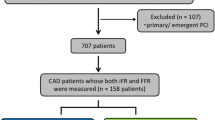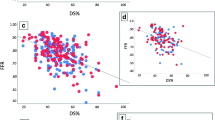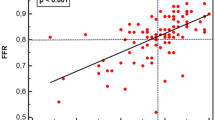Abstract
We sought to recognize the blood flow velocity (BFV) through the left anterior descending (LAD) coronary artery and its small intramyocardial (IM) branches by transthoracic Doppler-echocardiography in patients with aortic stenosis (AS). Sixty-two patients, aged 74.0 ± 9.6 years, 37 women, with preserved left ventricular (LV) function, apparently free of active ischemic disease, were enrolled and classified into 3 groups according to the mean gradient (MG) across the aortic valve: 13 patients (21%) entered the group A (MG ≤ 20 mmHg), 29 (48%) group B (MG 21–40 mmHg) and 20 (31%) group C (MG > 40 mmHg). Peak and mean coronary BFVs were demonstrated to gradually increase according to AV gradient, especially through the IM arteries. Peak IM-BFV was 58.9 cm/s (95% CI 46.4–71.4) in group A, 73.2 cm/s (95% CI 64.8–81.6) in group B, and 96.4 cm/s (95% CI 86.3–106.5) in group C (p < 0.001), whereas peak LAD-BFV was 38.1 cm/s (95% CI 32.8–43.3), 44.4 cm/s (95% CI 40.9–47.9) and 47.3 cm/s (95% CI 43.1–52.5), respectively (p = 0.03). Also, 34 patients complaining with unspecific symptoms showed much higher IM-BFV than those who were not. High values were also recognized in patients with LV ejection fraction/velocity ratio (EFVR) ≤ 0.90 (IM-BFV 91 ± 26 cm/s vs. 72 ± 24 cm/s in those with EFVR > 0.90, p = 0.001). In conclusion, AS patients in the present study showed gradually higher coronary BFVs according to AS gradient, especially through the IM vessels, and both peak and mean velocities were discriminating specific patient subsets. Pathophysiological mechanisms and potential clinical implications are discussed.
Similar content being viewed by others
References
Otto CM, Lind BK, Kitzman DW, Gersh BJ, Siscovick DS (1999) Association of aortic-valve sclerosis with cardiovascular mortality and morbidity in the elderly. N Engl J Med 341:142–147
Rosenhek R, Klaar U, Schemper M, Scholten C, Heger M, Gabriel H, Binder T, Maurer G, Baumgartner H (2004) Mild and moderate aortic stenosis. Natural history and risk stratification by echocardiography. Eur Heart J 25:199–205
Généreux P, Stone GW, O’Gara PT, Marquis-Gravel G, Redfors B, Giustino G, Pibarot P, Bax JJ, Bonow RO, Leon MB (2016) Natural history, diagnostic approaches, and therapeutic strategies for patients with asymptomatic severe aortic stenosis. J Am Coll Cardiol 67:2263–2288
Rashedi N, Otto CM (2015) Aortic stenosis: changing disease concepts. J Cardiovasc Ultrasound 23:59–69
Nishimura RA, Otto CM, Bonow RO, Carabello BA, Erwin JP 3rd, Fleisher LA, Jneid H, Mack MJ, McLeod CJ, O’Gara PT, Rigolin VH, Sundt TM 3rd, Thompson A (2017) 2017 AHA/ACC focused update of the 2014 AHA/ACC Guideline for the management of patients with valvular heart disease: a report of the American College of Cardiology/American Heart Association Task Force on Clinical Practice Guidelines. J Am Coll Cardiol 70:252–289
Hozumi T, Yoshida K, Akasaka T, Asami Y, Ogata Y, Takagi T, Kaji S, Kawamoto T, Ueda Y, Morioka S (1998) Noninvasive assessment of coronary flow velocity and coronary flow velocity reserve in the left anterior descending coronary artery by Doppler echocardiography. Comparison with invasive technique. J Am Coll Cardiol 32:1251–1259
Shibayama K, Daimon M, Watanabe H, Kawata T, Miyazaki S, Morimoto-Ichikawa R, Maruyama M, Chiang SJ, Miyauchi K, Daida H (2016) Significance of coronary artery disease and left ventricular afterload in unoperated asymptomatic aortic stenosis. Circ J 80:519–525
Banovic M, Bosiljka VT, Voin B, Milan P, Ivana N, Dejana P, Danijela T, Serjan N (2014) Prognostic value of coronary flow reserve in asymptomatic moderate or severe aortic stenosis with preserved ejection fraction and nonobstructed coronary arteries. Echocardiography 31:428–433
Meimoun P, Czitrom D, Clerc J, Seghezzi JC, Martis S, Berrebi A, Elmkies F (2017) Noninvasive coronary flow reserve predicts response to exercise in asymptomatic severe aortic stenosis. J Am Soc Echocardiogr 30:736–744
Youn HJ, Redberg RF, Schiller NB, Foster E (1999) Demonstration of penetrating intramyocardial coronary arteries with high-frequency transthoracic echocardiography and Doppler in human subjects. J Am Soc Echocardiogr 12:55–63
Watanabe N, Akasaka T, Yamaura Y, Akiyama M, Kaji S, Saito Y, Yoshida K (2003) Intramyocardial coronary flow characteristics in patients with hypertrophic cardiomyopathy: non-invasive assessment by transthoracic Doppler echocardiography. Heart 89:657–658
de Gregorio C (2005) Can we finally measure blood flow velocity all through the coronary artery three by transthoracic Doppler echocardiography in patients with myocardial hypertrophy? J Am Soc Echocardiogr 18:1464–1466
Baumgartner H, Hung J, Bermejo J, Chambers JB, Edvardsen T, Goldstein S, Lancellotti P, LeFevre M, Miller F Jr, Otto CM (2017) Recommendations on the echocardiographic assessment of aortic valve stenosis: a focused update from the European Association of Cardiovascular Imaging and the American Society of Echocardiography. Eur Heart J Cardiovasc Imaging 18:254–275
de Gregorio C, Micari A, Grimaldi P, Bragadeesh T, Arrigo F, Coglitore S (2005) Behavior of both epicardial and intramural coronary artery flow velocities in various models of myocardial hypertrophy: role for left ventricular outflow tract obstruction. Am Heart J 149:1091–1098
Antonini-Canterin F, Pavan D, Burelli C, Cassin M, Cervesato E, Nicolosi GL (2000) Validation of the ejection fraction-velocity ratio: a new simplified function-corrected index for assessing aortic stenosis severity. Am J Cardiol 86:427–433
Antonini-Canterin F, Di Nora C, Cervesato E, Zito C, Carerj S, Ravasel A, Cosei I, Popescu AC, Popescu BA (2018) Value of ejection fraction/velocity ratio in the prognostic stratification of patients with asymptomatic aortic valve stenosis. Echocardiography 35:1909–1914
Rajappan K, Rimoldi OE, Dutka DP, Ariff B, Pennell DJ, Sheridan DJ, Camici PG (2002) Mechanisms of coronary microcirculatory dysfunction in patients with aortic stenosis and angiographically normal coronary arteries. Circulation 105:470–476
Boekholdt SM, Arsenault BJ, Mathieu P (2017) Coronary artery disease affects symptomatology of aortic valve stenosis. J Am Coll Cardiol 70:1103–1104
Gutiérrez-Barrios A, Gamaza-Chulián S, Agarrado-Luna A, Ruiz-Fernández D, Calle-Pérez G, Marante-Fuertes E, Zayas-Rueda R, Alba-Sánchez M, Oneto-Otero J, Vázquez-Garcia R (2017) Invasive assessment of coronary flow reserve impairment in severe aortic stenosis and echocardiographic correlations. Int J Cardiol 236:370–374
Youn HJ, Lee JM, Park CS, Ihm SH, Cho EJ, Jung HO, Jeon HK, Oh YS, Chung WS, Kim JH, Choi KB, Hong SJ (2005) The impaired flow reserve capacity of penetrating intramyocardial coronary arteries in apical hypertrophic cardiomyopathy. J Am Soc Echocardiogr 18:128–132
de Gregorio C, Micari A, Di Bella G, Carerj S, Coglitore S (2005) Systolic wall stress may affect the intramural coronary blood flow velocity in myocardial hypertrophy, independently on the left ventricular mass. Echocardiography 22:642–648
Sherrid MV, Mahenthiran J, Casteneda V, Fincke R, Gasser M, Barac I, Thayaparan R, Chaudhry FA (2006) Comparison of diastolic septal perforator flow velocities in hypertrophic cardiomyopathy versus hypertensive left ventricular hypertrophy. Am J Cardiol 97:106–112
Sun Y, Gewirtz H (1988) Estimation of intramyocardial pressure and coronary blood flow distribution. Am J Physiol 255:H664–H672
Gould KL (2009) Does coronary flow trump coronary anatomy? JACC Cardiovasc Imaging 2:1009–1923. Erratum in (2009) JACC Cardiovasc Imaging 2:1146
Kaul S, Ito H (2004) Microvasculature in acute myocardial ischemia: part I. Evolving concepts in pathophysiology, diagnosis, and treatment. Circulation 109:146–149
Kaul S, Ito H (2004) Microvasculature in acute myocardial ischemia: part II: evolving concepts in pathophysiology, diagnosis, and treatment. Circulation 109:310–315
Nemes A, Forster T, Kovács Z, Csanády M (2006) Is the coronary flow velocity reserve improvement after aortic valve replacement for aortic stenosis transient? Results of a 3-year follow-up. Heart Vessels 21:157–161
Garcia D, Camici PG, Durand LG, Rajappan K, Gaillard E, Rimoldi OE, Pibarot P (2009) Impairment of coronary flow reserve in aortic stenosis. J Appl Physiol 106:113–121
Gerdts E, Rossebø AB, Pedersen TR, Cioffi G, Lønnebakken MT, Cramariuc D, Rogge BP, Devereux RB (2015) Relation of left ventricular mass to prognosis in initially asymptomatic mild to moderate aortic valve stenosis. Circ Cardiovasc Imaging 8:e003644
Akahori H, Tsujino T, Masuyama T, Ishihara M (2018) Mechanisms of aortic stenosis. J Cardiol 71:215–220
Treibel TA, Lopez B, Gonzalez A, Menacho K, Schofield R, Ravassa S, Fontana M, White SK, Di Salvo C, Roberts N, Ashworth MT, Díez J, Moon JC (2018) Reappraising myocardial fibrosis in severe aortic stenosis: an invasive and non-invasive study in 133 patients. Eur Heart J 39:699–709
Lancellotti P, Magne J, Dulgheru R, Clavel MA, Donal E, Vannan MA, Chambers J, Rosenhek R, Habib G, Lloyd G, Nistri S, Garbi M, Marchetta S, Fattouch K, Coisne A, Montaigne D, Modine T, Davin L, Gach O, Radermecker M, Liu S, Gillam L, Rossi A, Galli E, Ilardi F, Tastet L, Capoulade R, Zilberszac R, Vollema EM, Delgado V, Cosyns B, Lafitte S, Bernard A, Pierard LA, Bax JJ, Pibarot P, Oury C (2018) Outcomes of patients with asymptomatic aortic stenosis followed up in heart valve clinics. JAMA Cardiol 3:1060–1068
Carstensen HG, Larsen LH, Hassager C, Kofoed KF, Jensen JS, Mogelvang R (2015) Association of ischemic heart disease to global and regional longitudinal strain in asymptomatic aortic stenosis. Int J Cardiovasc Imaging 31:485–495
Mygind ND, Michelsen MM, Pena A, Qayyum AA, Frestad D, Christensen TE, Ghotbi AA, Dose N, Faber R, Vejlstrup N, Hasbak P, Kjaer A, Prescott E, Kastrup J, steering committee of the iPower study (2016) Coronary microvascular function and myocardial fibrosis in women with angina pectoris and no obstructive coronary artery disease: the iPOWER study. J Cardiovasc Magn Reson 18:76
Acknowledgements
The authors gratefully acknowledge Drs. Francesco Saporito and Giuseppe Andò and the nursing staff of the Cardiac Catheterization Lab of our Cardiology Unit (Messina University Hospital) for their precious collaboration.
Author information
Authors and Affiliations
Corresponding author
Ethics declarations
Conflict of interest
The authors declare that they have no conflict of interest.
Additional information
Publisher's Note
Springer Nature remains neutral with regard to jurisdictional claims in published maps and institutional affiliations.
Rights and permissions
About this article
Cite this article
de Gregorio, C., Grimaldi, P., Ferrazzo, G. et al. Pathophysiological and clinical implications of high intramural coronary blood flow velocity in aortic stenosis. Heart Vessels 35, 637–646 (2020). https://doi.org/10.1007/s00380-019-01532-9
Received:
Accepted:
Published:
Issue Date:
DOI: https://doi.org/10.1007/s00380-019-01532-9








